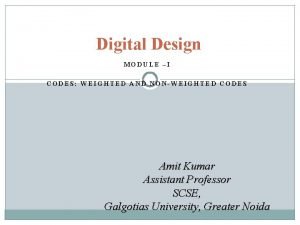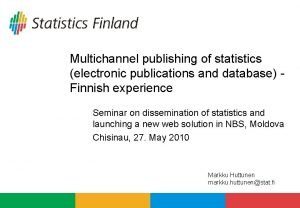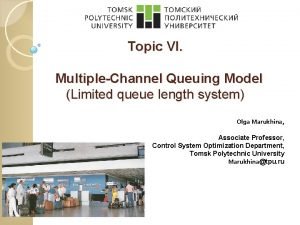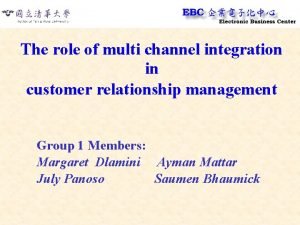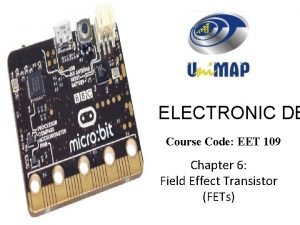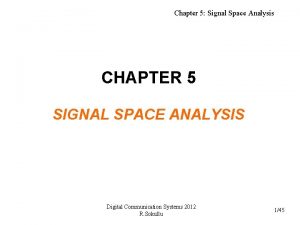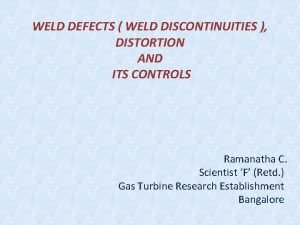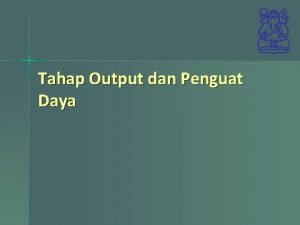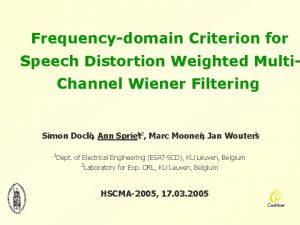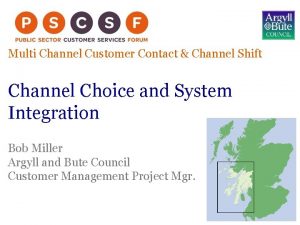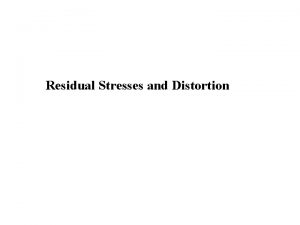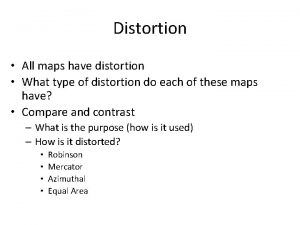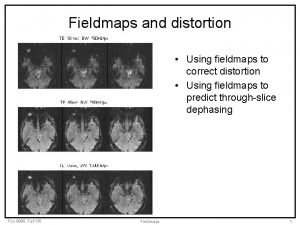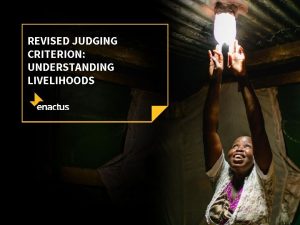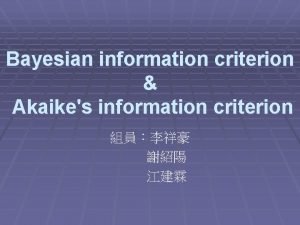Frequencydomain Criterion for Speech Distortion Weighted Multi Channel
















- Slides: 16

Frequency-domain Criterion for Speech Distortion Weighted Multi. Channel Wiener Filtering 1 1 2 Simon Doclo , Ann Spriet 1, 2, Marc Moonen , Jan Wouters 1 Dept. of Electrical Engineering (ESAT-SCD), KU Leuven, Belgium 2 Laboratory for Exp. ORL, KU Leuven, Belgium HSCMA-2005, 17. 03. 2005

Overview • Adaptive beamforming: GSC o Not robust against signal model errors • Spatially-preprocessed SDW-MWF: o Increase robustness of adaptive stage by taking speech distortion into account o Implementation: stochastic gradient algorithms o Frequency-domain criterion o Experimental validation in hearing instruments • Audio demonstration • Conclusions 2

Hearing instruments § Introduction § Adaptive beamforming § Experimental validation § Audio demo § Conclusions • Hearing problems effect more than 10% of population hearing aids and cochlear implants • Digital hearing instruments allow for advanced signal processing, resulting in improved speech understanding • Major problem: (directional) hearing in background noise o o reduction of noise wrt useful speech signal multiple microphones + DSP in BTE current systems: simple fixed and adaptive beamforming robustness important due to small inter-microphone distance design of robust multi-microphone noise reduction scheme 3

GSC = Adaptive MVDR-beamformer § Introduction § Adaptive beamforming -GSC -SP-SDW-MWF -Implementation Spatial pre-processor (Fixed beamforming) 0° 0° G Adaptive stage (Adaptive Noise Canceller) speech reference + speech + noise § Experimental -- validation § Audio demo § Conclusions 0° noise references noise + speech leakage Avoids speech distortion Filter w 1 speech + noise distorted speech + noise Filter w 2 Minimises output noise power Relies on assumptions known mic characteristics, known speaker position, no reverberation Violated in practice Speech distortion ! 4

Robustness against model errors § Introduction • § Adaptive beamforming -GSC -SP-SDW-MWF -Implementation Spatial pre-processor and adaptive stage rely on assumptions that are generally not satisfied in practice: o Distortion of speech component in speech reference o Leakage of speech into noise references, i. e. Speech component in output signal gets distorted § Experimental validation § Audio demo § Conclusions • Design of robust noise reduction algorithm: 1. Reduce speech leakage contributions in noise references: • Robust fixed spatial filter [Nordebo 94, Doclo 03] • Adaptive blocking matrix [Van Compernolle 90, Hoshuyama 99, Herbordt 01] • Estimate relative acoustic transfer functions [Gannot 01] 2. Reduce effect of present speech leakage: • Only update adaptive filter during low-SNR periods/frequencies • Quadratic inequality constraint, leaky LMS [Cox 87, Claesson 92, Tian 01] • Take speech distortion explicitly into account, SDW-MWF [Spriet 04] 5

Design of robust adaptive stage § Introduction • Distorted speech in output signal: § Adaptive • Robustness: limit beamforming -GSC -SP-SDW-MWF -Implementation § Experimental validation by controlling adaptive filter o Quadratic inequality constraint (QIC-GSC): = conservative approach, constraint f (amount of leakage) o Take speech distortion into account in optimisation criterion (SDW-MWF) § Audio demo § Conclusions noise reduction speech distortion – 1/ trades off noise reduction and speech distortion (1/ = 0 GSC, 1/ = 1 MMSE estimate) – Regularisation term ~ amount of speech leakage Limit speech distortion, while not affecting noise reduction performance in case of no model errors QIC 6

Implementation § Introduction § Adaptive beamforming -GSC -SP-SDW-MWF -Implementation § Experimental • Algorithms: o Recursive matrix-based (GSVD, QRD) – too expensive o Stochastic gradient algorithms (time vs. frequency domain) • Stochastic gradient algorithm (time-domain): o Cost function validation § Audio demo § Conclusions results in LMS-based updating formula Classical GSC regularisation term o Practical computation of regularisation term using data buffers o Reduce complexity by frequency-domain implementation [Spriet 04] Still large memory requirement due to data buffers o Memory reduction by approximating FD regularisation term [Doclo 04] 8

Frequency-domain criterion (1) § Introduction § Adaptive • Extension of block-based frequency-domain criterion for multi -channel AEC [Benesty 01, Buchner 03] beamforming -GSC -SP-SDW-MWF -Implementation § Experimental validation § Audio demo § Conclusions • Set derivative wrt time-domain filter coefficients w to zero normal equations in FD • Recursive algorithm (details cf. book “Speech Enhancement”) 9

Frequency-domain criterion (2) § Introduction • Practical calculation of regularisation term averaging § Adaptive beamforming -GSC -SP-SDW-MWF -Implementation § Experimental validation • Approximations for reducing the computational complexity: o Approximate and by block-diagonal (or diagonal) correlation matrices : § Audio demo § Conclusions (block-)diagonal matrices can be easily inverted Ensure that is positive-definite: eigenvalues of (block-)diagonal matrix can be easily computed o Constrained vs. unconstrained update : corresponds to setting derivate wrt frequency-domain filter coefficients to zero 10

Experimental results mic 1 mic 2 § Introduction Configuration § Adaptive • 3 -mic BTE on dummy head (d = 1 cm, 1. 5 cm) beamforming • Speech source in front of dummy head (0 ) § Experimental • 5 speech-like noise sources: 75 , 120 , 180 , 240 , 285 • Gain mismatch validation -Performance -Complexity § Audio demo mic 3 = 4 d. B at 2 nd microphone Reverberation time = 500 msec § Conclusions Noise 5 Noise 1 H. A. Noise 4 Noise 3 11

Performan ce measures § Introduction § Adaptive beamforming • Improvement in speech intelligibility [d. B] speech noise § Experimental validation -Performance -Complexity f § Audio demo - § Conclusions [d. B] Importance of i-th band for speech intelligibility • Speech distortion [d. B] input speech output speech - f [d. B] 12

Experimental validation (1) § Introduction § Adaptive beamforming § Experimental • SDR-GSC (unconstrained update) o Results after convergence (L=32, =0. 5, =0. 995, BD/D stepsize) o GSC (1/ = 0) : degraded performance if significant leakage o 1/ > 0 increases robustness (speech distortion noise reduction) validation -Performance -Complexity § Audio demo § Conclusions GSC 13

Experimental validation (2) § Introduction § Adaptive beamforming § Experimental • Convergence behaviour: o Convergence speed: block-diagonal step size > diagonal step size o large fast convergence o large slow convergence, better performance upon convergence validation -Performance -Complexity § Audio demo § Conclusions 14

Complexity + memory § Introduction • Parameters: M = 3 ( mics), N = 2 (a), N = 3 (b), L = 32, fs = 16 k. Hz, Ly = 10000 § Adaptive • Computational complexity: beamforming Algorithm Complexity (MAC) MIPS QIC-GSC (FD) (3 M-1)FFT + 16 M - 9 2. 16 SDW-MWF (FD-buffer) (3 N+5)FFT + 30 N + 10 3. 22(a), 4. 27(b) § Audio demo SDW-MWF (FD-matrix-diag) (3 N+2)FFT + 8 N 2 + 13 N 2. 46(a), 3. 89(b) § Conclusions SDW-MWF (FD-matrix-BD) (3 N+2)FFT + 14 N 2 + 10 N + 12 2. 94 (N=2 !) § Experimental validation -Performance -Complexity • Memory requirement: Algorithm Memory k. Words QIC-GSC (FD) 4(M-1)L + 6 L 0. 45 SDW-MWF (FD-buffer) 2 NLy + 6 LN + 7 L 40. 61 SDW-MWF (FD-matrix-all) 4 LN 2 + 6 LN + 7 L 1. 12 (a), 60. 80 1. 95 (b) Complexity and memory comparable to QIC-GSC 15

Audio demonstration § Introduction Algorithm No deviations Deviation (4 d. B) § Adaptive beamforming Noisy microphone signal § Experimental validation § Audio demo Speech reference § Conclusions Noise reference Output GSC (1/ = 0) Output SDR-GSC (1/ = 0. 5) (L=32, =10, =0. 99875, block-diagonal stepsize, unconstrained update ) 16

Conclusions § Introduction • Spatially pre-processed SDW-MWF: § Adaptive o Take speech distortion explicitly into account improve robustness of adaptive stage § Experimental o Encompasses GSC and MWF as special cases beamforming validation § Audio demo § Conclusions • Implementation: o Stochastic gradient algorithms in time- and frequency-domain o Frequency-domain criterion: block-based processing natural derivation of different adaptive algorithms o Block-diagonal vs. diagonal, constrained vs. unconstrained o Comparable implementation cost as QIC-GSC • Experimental results: o SP-SDW-MWF achieves better noise reduction than QIC-GSC, for a given maximum speech distortion level o Faster convergence speed for block-diagonal step size matrix 17
 Waiting line management
Waiting line management Types of multi channel retailing
Types of multi channel retailing Non weighted codes examples
Non weighted codes examples Multi loop pid controller regolatore pid multi loop
Multi loop pid controller regolatore pid multi loop Channel of distribution
Channel of distribution Multi-channel publishing system
Multi-channel publishing system Multi channel queuing model
Multi channel queuing model Multi channel publishing
Multi channel publishing Multichannel retailing ppt
Multichannel retailing ppt Multi channel integration process
Multi channel integration process A multichannel retailer sells merchandise
A multichannel retailer sells merchandise Distribution channel system
Distribution channel system Pengertian multi channel
Pengertian multi channel Determine id
Determine id Conversion of continuous awgn channel to vector channel
Conversion of continuous awgn channel to vector channel Desirable fillet weld profiles
Desirable fillet weld profiles Amplifier distortion
Amplifier distortion


